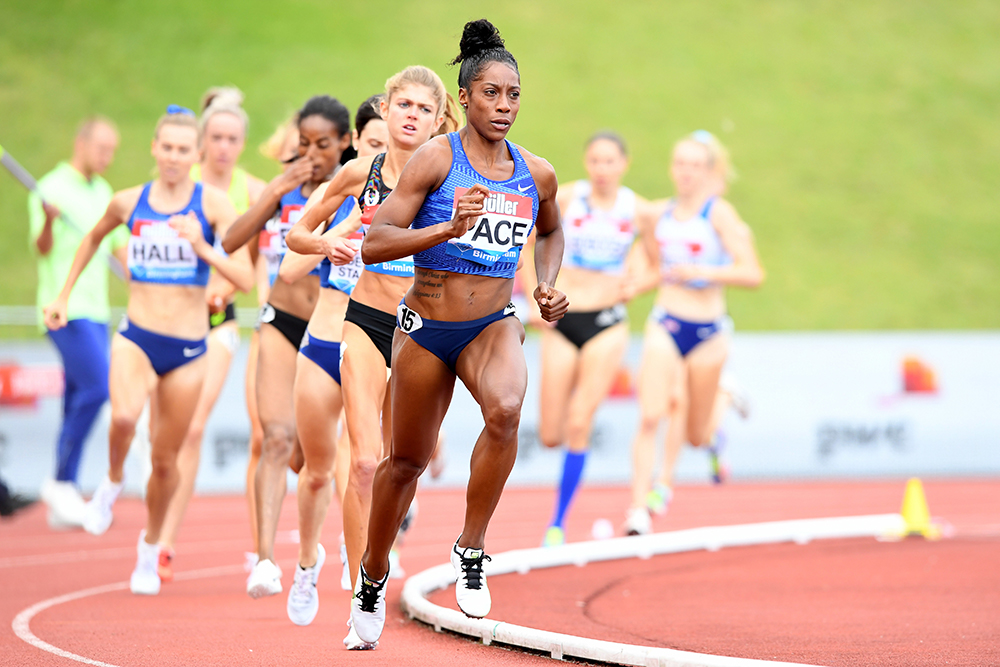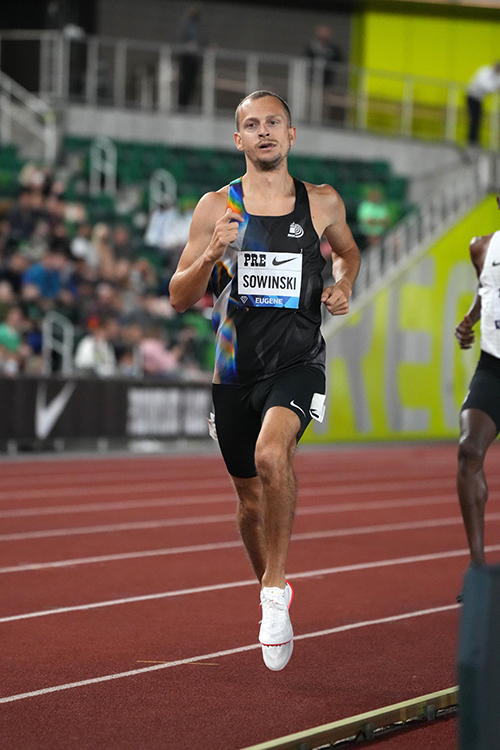
FOR BOTH Chanelle Price and Erik Sowinski, the road to becoming the most in-demand rabbits on the big-league middle distance scene started with World Records.
For Price, it was ’15, the year after she won gold in the World Indoor 800, when she was racing on the European circuit: “There was talk of Genzebe Dibaba going after the [1500] World Record in Monaco and they wanted a very fast pace through the 800 for her. My agent suggested my name to the meet director and persuaded him I would do a good job because I like to front-run, so I’m comfortable out there in the front. I know how to hit paces. So the director took a chance on me.”
Price led Dibaba through 800 in 2:04.51 on the Ethiopian’s way to the still-standing WR of 3:50.07. Our report at the time called it “perfect pacing.”
“So after that,” Price says, “it was kind of like, ‘We want Chanelle’ and that’s how it started.”
Sowinski’s first spin as a rabbit came in ’19 when Yomif Kejelcha targeted the indoor mile WR in Boston. Twice the USATF indoor champ, 800 specialist Sowinski led the Ethiopian past the first quarter in what T&FN called a “carefully choreographed race” that led to the still-standing WR of 3:47.01.
But Iowa alum Sowinski didn’t really jump into the game with both feet until this season, when he rapidly developed a reputation for hitting close-to-perfect splits. He had known the director of the Gateshead DL for some time, so when the meet needed a rabbit for the 1500, Sowinski got a call.
“I flew over there from New York, actually got in the morning of the race, paced that one, and then it just kind of took off.”
One might think that with the new Wavelight pacing technology flashing along the curbs of some of the world’s top tracks, rabbits might be a dying breed. Not so. All the top meets are still using human hares alongside the electronics.
“It’s almost like a pacer for the pacer,” says Price. “It really helps because sometimes I could be a little too fast. Those lights are really telling me whether I’m on or not.” Plus, she adds, “The benefit of having a pacer is blocking some of the wind. It’s beneficial to have an actual body out there helping.”
Sowinski loves the lights, explaining, “It makes it a lot easier. Honestly, I just kind of get to shut my brain off a little bit more and don’t have to look at the clocks as much.
“I’ve talked to a lot of the guys and in the races, they don’t really notice the Wavelight. It’s more for the pacers than anything, and also a general thing for the fans to see the milestones that those athletes are shooting for.”
There is preparation involved in being a dependable rabbit. Price and Sowinski, both 31, have fitness galore from their main events. Price placed 5th in the OT 800 last summer with a PR 1:58.73. Sowinski’s PR 1:44.58 dates from ’14; this year he ran 1:45.47 in the Trials first round.
On top of that, Price reports that her usual routine is to hit the track the day before “and run some 200s at the rhythm they’re asking for. And sometimes they’ll ask me to come practice with the lights.”
For Gateshead, Sowinski says, “I did a couple of reps at that 55/56-second 400 pace, because it’s not usually a rhythm that I hit a lot in practice.” Most of the time, though, he feels he doesn’t need the refresher. “I’ve always been really good at pacing myself in practice. And I’ve been in so many 800s that have gone so many different ways, I think it’s just experience more than anything that’s helped me at that.”
Still, not every pacing experience goes smoothly. We’ve all seen races where the contenders seem to have no interest in following the prescribed tempo.
“In my head I’m thinking, ‘Ooh man!’” says Price of being out front all alone. “I don’t want to just be out there in La La Land, not helping anybody. That’s one of the more frustrating situations…
“The first lap I usually always try to hit the target pace. Then it’s up to me to make a decision whether I’m going to stay on that pace or actually slow down and help the field.”

Sowinski admits that this season he hasn’t faced many of those situations in the 1500/mile, usually thanks to Australia’s Stewart McSweyn, a 3:48 miler who loves to be right on the rabbit. “I really love the way that guy races,” he says. “He asks for a pace, and you know he’s going to go with it, regardless of what it is.”
He adds that the trickier event in that regard is the 800, when often the directors ask for a fast opener. “Everyone gets out really hard the first 100–150 and then it slows down. It just exaggerates how far the pacer looks like they’re ahead when they’re just doing their job.”
In many of those cases where the rabbit is all alone out front, there’s a good bet that one of the commentators will mention one of those (few) times the early leader stole the race, the most famous example dating to the ’81 Bislett Games (see sidebar), where lightly regarded field filler American Tom Byers beat World Record holder Steve Ovett in a fluke 1500 result.
Have today’s top rabbits ever been tempted to stay in the fight? Price admits she had the urge in the Gateshead mile this year. “They did not come with me at all. I had like a 50m lead, even trying to slow down. It was very, very slow and the furthest I’ve ever gone; I went 1200m.
“I thought about it. I would’ve had one lap to go and I’m like, ‘Should I keep going?’ But I didn’t want to get in trouble. I wanted to get asked to pace again. Afterward, my agent was like, ‘Chanelle, you should have just finished!’ I was like, ‘Oh, I don’t know what the rules are.’”
She dropped at the bell and watched Kate Grace storm to the win in 4:27.20.
Sowinski says he has only felt the temptation while pacing an 800. “In a couple of them, I was told not to go further than x-meters, so I didn’t want to press my luck. As far as the 1500, that’s not really my forte, so I don’t think that even if I stayed in the race, I’d be super-relevant.”
Balancing rabbiting excursions with training and racing their main event can be challenging. Price thinks the rabbiting helps her 800s. “The strength side of the 800 is something that I still have room to grow in. Anytime I’m asked to go further than 800, mentally and physically it’s making me a bit stronger.”
The challenge for Sowinski is the schedule itself, when too many pacing gigs take away his own racing opportunities. “On this last trip I wish I would have had one or two more 800 races I could have squeezed in there.”
It affects his preparation a bit, he adds. “I’m just a guy that’s used to a lot of high, high-quality work. Not to say that going through in 51 and continuing to 900m isn’t high quality, but I’m kind of used to a little bit faster stuff. So I might have sacrificed a little bit of that kind of work, but the more that we do this and hone the training to coordinate with pacing, I think that will definitely help the 800.”
Ultimately, in a world where many top athletes are struggling to pay the rent, rabbiting is a paying gig, at least at the major meets. Tennessee alum Price, who says this season was her last, was open about the compensation.
“I usually do the Diamond Leagues and the base for those, for me at least, is $2000 and then there are always bonuses if it was a meet record or a world lead or an area record or a World Record. The price goes up depending on how well the ladies perform.” In addition, there’s hotel and airfare.
Sowinski, who is newer to the business, admits, “I don’t know how much other pacers make.” Without giving numbers, he estimates that he thinks he takes home as much as the guys in the middle of the field. “I probably could have asked for more the more successful I was throughout the year, but I just wanted to show everyone, ‘Hey, I can do this and I can do this consistently.’
“If I decide to do this longterm I think I could lean on what I’ve done in the past to ask for a little bit more going forward.”
There are other pluses beyond financial. Says Sowinski, “It’s been a lot of fun. Obviously, I still prefer racing, but the more opportunities I get on a starting line, regardless of what it is, I enjoy it every time out there.” In Gateshead, he even did a double, leading the mile at 55.73/1:53.81, then a little more than an hour later, towing the 800 through a 49.83.
The role is valuable, says Price. “When I’m able to help them hit the mark they want to hit, just to see their appreciation and hear ‘thank you’ and they give me a hug, it really does feel good to know that I did my job correctly and I helped them reach their goal. It is very satisfying.”
As Price decided she would be hanging up her spikes after this season, an agent told her, “We’re losing the world’s best pacer!”
“I was like, ‘Well, you’ll find somebody else.’ I never really went out to be known as a 1500 pacemaker, but I’m really glad that I did it, and that I’ve been able to do it over these past few years. It’s been fun and financially it helps.”